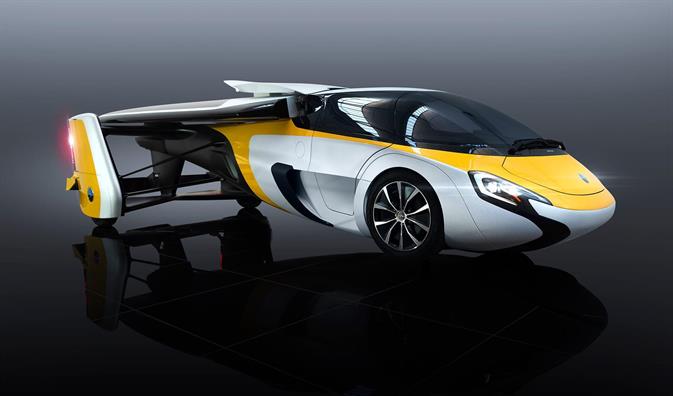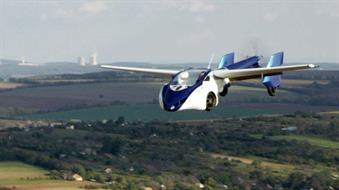A free template by Lucknowwebs.com for WYSIWYG WebBuilder 8
Nigel G Wilcox
Paragon Of Space Publication
© Copyright Reserved - United Kingdom
Ideal Screen Composition 1024 x 768
Best Flying Cars Around the World
© 2019 AeroMobil
AeroMobil 4.0
The AeroMobil 3.0, created by Slovakian company AeroMobil, is probably what you would you draw if someone asked you what a flying car looks like. When in car mode, the wings store neatly along the fuselage and open up when you want to take to the skies.
Max Speed: 100mph in the air/45mph on the road
Engine: AeroMobil custom 2.0 l turbo charged 4-cylinder boxer internal combustion engine
Range: 62 miles
Courtesy: pocket-lint.com
It has what you would consider conventional wheels, that are incredibly light and strong enough to handle landings at airports. The interior isn't too dissimilar to cars on the road today, with screens that display road information when in car mode, and switch to flight info when you take off.
AeroMobil says it should be fully operational by 2020.
SLOVAKIAN COMPANY AeroMobil launched its flying car in 2014, although when the test vehicle crashed in 2015 it looked to be all over. Fast forward to now and the company says its latest model, the AeroMobil 4.0 is safer, stronger, faster and better than ever.
More importantly, it’s also fully certified for both road and air use. It was launched at the Top Marques Show this week in Monaco.
“Today is a transformative day for the future of travel as the launch of the AeroMobil means and that everyday flying transportation will soon be a reality,” said Juraj Vaculik, co-founder and CEO of AeroMobil. “To get to this point has seen us bring together a strong team of the best minds and experts in cutting edge automotive, motorsport and aerospace to redefine the boundaries of what is possible in transportation.
Safety has been improved with the exterior and wings constructed from carbon-composite materials. “The vehicle’s cockpit is designed to surround the pilot and co-pilot in a high strength monocoque structure that is capable of absorbing and distributing crash and impact energy while maintaining interior integrity. It also incorporates the very latest in vehicle recovery ballistic parachute technology, designed to bring an airborne vehicle back to ground safely should the pilot choose to deploy it. While travelling on the road the occupant restraint system uses pyrotechnic seatbelt technology in conjunction with dual-stage airbags. These systems are equally capable of offering occupant protection should the vehicle get into difficulties while operating as a plane,” AeroMobil said in a statement.
The AeroMobil 4.0 is powered, in road mode, by an electric motor powering the front wheels, and a 2.0-litre turbocharged four-cylinder for the propeller, producing 224kW.
“This launch is a triumph of engineering and design, requiring all our creativity, imagination, passion and technical expertise to deliver an innovative product that is truly ground-breaking,” added Douglas MacAndrew, Chief Technology Officer, AeroMobil. “Everyone in this sector must overcome complex technical challenges in the process of developing a flying vehicle. We believe the vehicle presented today successfully resolves these challenges demonstrating a product that does not compromise either air or road function. The outcome is a flying car that combines innovative features with a recognisable, high quality experience that pilots and drivers have come to expect.”
The AeroMobil 4.0 is available for order now with prices in excess of $1.5 million with the company’s first vehicle limited to just 500 units.
“To significantly reduce the cost of flying cars in the long-term, we are bringing an automotive high-volume approach to a traditionally conservative low-volume aerospace industry, significantly cutting components costs via smart design, novel materials and production automation whilst fully conforming with civil aviation industry requirements” said Juraj Vaculik, CEO, AeroMobil.
Key Facts about the AeroMobil Flying Car
Full transformation into flight mode in less than 3 minutes;
Automotive Range -700km (estimated using NEDC cycle);
Aerospace Max Cruise Range ~750 km @ 75% (1200m, ISA);
Fuel Capacity 90 ltr (95 RON Gasoline);
Direct Drive variable pitch propeller (speed 2400rpm);
Automotive - Top speed 160 km/h;
Aerospace - Vs / Vc / VD - 112 / 259 / 360 km/h;
MTOW Take Off Distance ground roll / 50 ft - 397 / 595 m; and
Max Take Off Weight - 960 kg (useable load 240 kg).
SITEMAP
SCIENCE RESEARCH
ABOUT
Desk
MAIN INDEX
Flying Cars
S'sonic
Stealth
Menu
Space
Transport
Menu
Topic
Menu
Study
Menu





